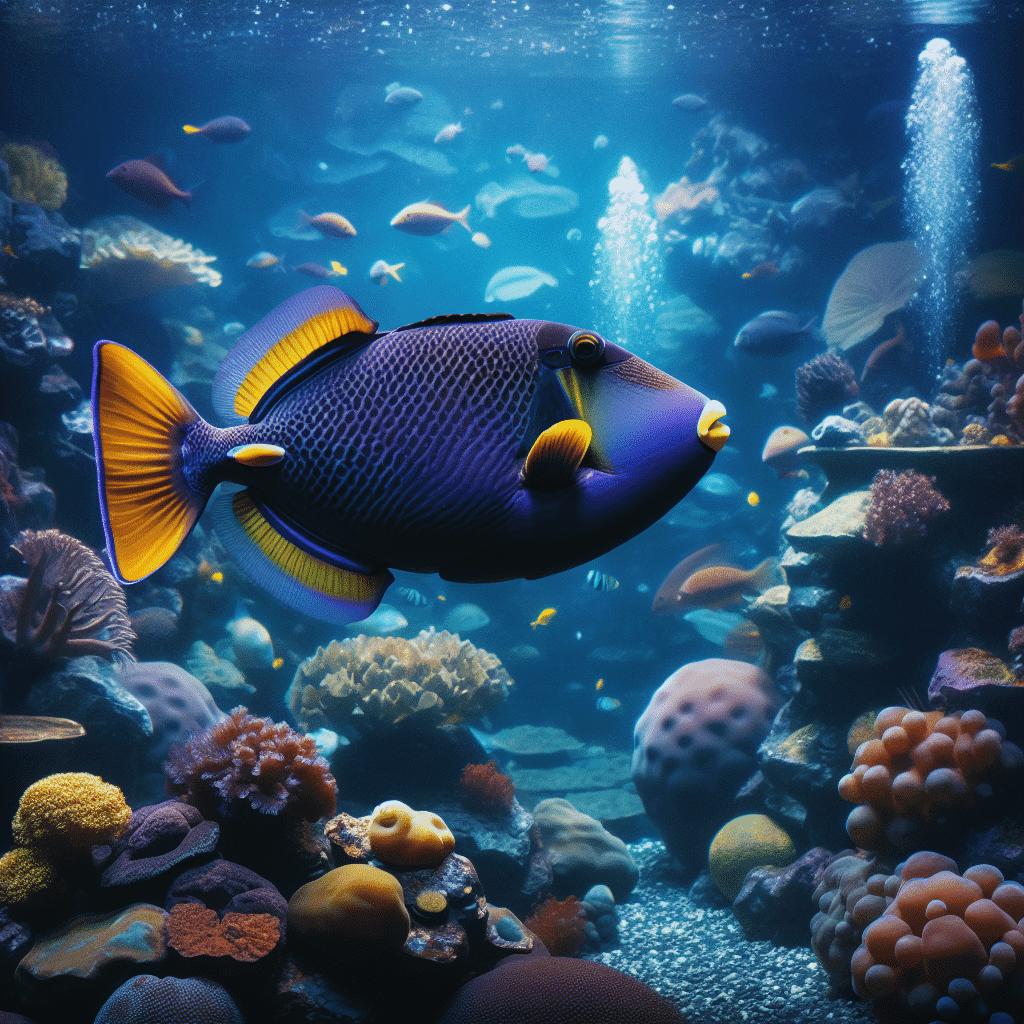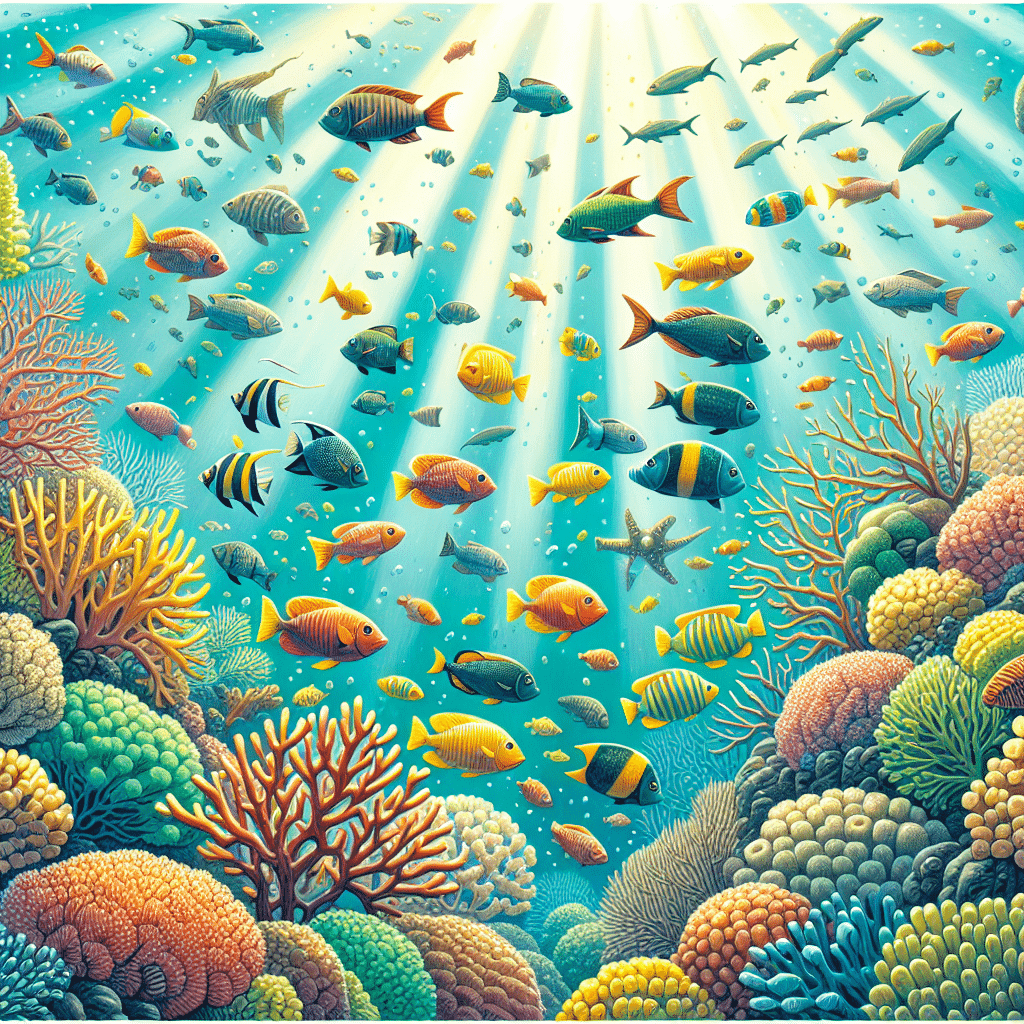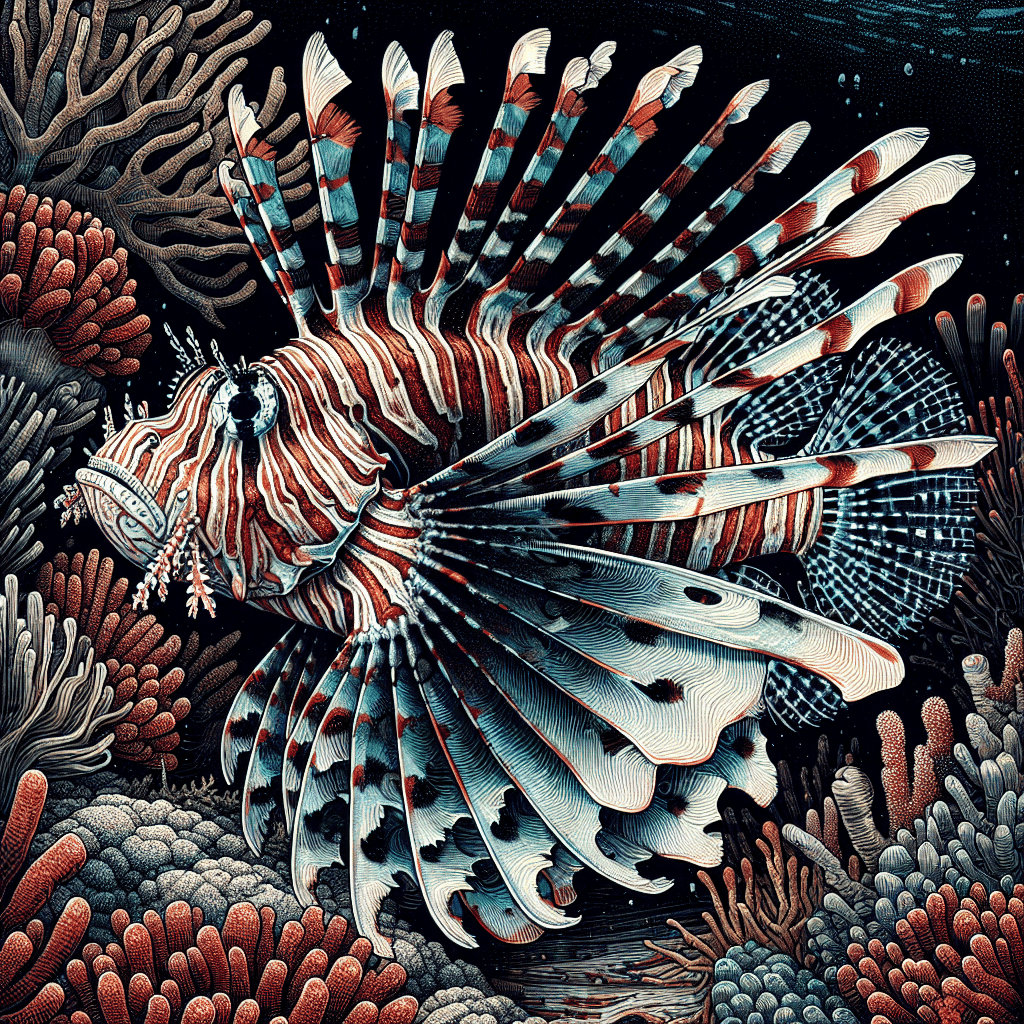Introduction to Niger Triggerfish
Meet the Redtoothed Beauty
Let me introduce you to the Niger Triggerfish, scientifically known as Odonus niger. This fish is not just a pretty face; it’s a compelling addition to any reef tank. Known commonly as the redtoothed triggerfish, blue triggerfish, or redfang triggerfish, it hails from the tropical Indo-Pacific region and is the sole member of its genus (Wikipedia).
What I find fascinating about this fish is its vibrant appearance and outgoing nature. The Niger Triggerfish boasts striking colors and can even change its hue depending on mood and environmental factors. It typically resides among rocks near reefs, where it feeds on zooplankton and microcrustaceans, often found up to 100 feet deep (Light Fish).
These fish are popular in the aquarium trade for several reasons. They are hardy, have an active swimming behavior, and their personality shines through in the way they interact with their environment. However, they do require specific tank conditions to thrive, including aggressive tankmates and ample open space for swimming (Sustainable Aquatics).
If you’re considering adding a Niger Triggerfish to your reef tank, you’ll be adding a unique and dynamic creature that can be a real conversation starter among fellow aquarists. For more information on other marine fish that can coexist with the Niger Triggerfish, check out our section on marine fish.
Tank Requirements for Niger Triggerfish
Setting up the perfect tank for a Niger triggerfish is essential for their health and happiness. These fish are not only stunning but also have specific needs when it comes to their habitat.
Tank Size and Setup
Niger triggerfish can grow quite large, reaching up to 12 inches in length. Because of their size and active nature, I recommend a tank size of at least 180 gallons for adults. A larger aquarium, ideally 200 gallons or more, provides the necessary swimming space and stability, which is beneficial for this species (Sustainable Aquatics). Here’s a quick reference table for tank requirements:
| Age Stage | Minimum Tank Size |
|---|---|
| Juvenile (up to 10 inches) | 75 gallons |
| Adult (up to 12 inches) | 180 gallons |
| Large Adults (over 12 inches) | 200 gallons+ |
When setting up the tank, it’s important to include plenty of hiding spots and decorations, like rocks and caves, to simulate their natural environment. Ensure the water conditions are optimal for marine life, including proper filtration and water movement.
Suitable Tankmates
Choosing the right tankmates for Niger triggerfish is crucial, as they can be quite aggressive. They thrive best with other robust species that can handle their temperament. Suitable tankmates include:
- Lionfish
- Groupers
- Pufferfish (like valentini puffer)
- Seahorses (if the tank is large enough and well-planned)
- Clownfish (such as ocellaris clownfish)
Avoid pairing them with smaller or more docile fish, as they may become targets. It’s wise to monitor the tank dynamics closely and be prepared to separate any fish that show signs of stress or aggression.
By setting up the right environment and choosing compatible tankmates, I can ensure that my Niger triggerfish will thrive and display their beautiful personality in a healthy aquarium. For more information about marine fish and their care, check out our section on marine fish.
Feeding the Niger Triggerfish
Feeding my Niger triggerfish can be a fun and rewarding experience. These fish are not only beautiful but also have specific dietary needs that I need to consider to keep them healthy and happy.
Carnivorous Diet
Niger triggerfish are carnivores and thrive on a varied diet that includes a range of meaty foods. I like to feed them items such as shrimp, squid, and various types of fish. They also consume other marine life like krill, clams, and even urchins. To ensure that my fish have a balanced diet, I make sure to include hard-shelled foods that help maintain their dental health.
Here’s a quick reference table of some great food options for Niger triggerfish:
| Food Type | Description |
|---|---|
| Shrimp | Fresh or frozen; a staple for them. |
| Squid | Cut into small pieces for easier eating. |
| Clams | Whole or half shells; great for trimming teeth. |
| Krill | A nutritious option that they love. |
| Silversides | Small fish that provide variety. |
| Lance Fish | Another small fish option; high in protein. |
For more information on different types of fish that can thrive in a reef tank, check out our section on marine fish.
Feeding Techniques
When it comes to feeding techniques, I’ve noticed that Niger triggerfish can be quite aggressive eaters. I typically scatter the food around the tank to encourage natural foraging behavior. This not only keeps them active but also mimics their behavior in the wild, where they hunt for food.
I also prefer to feed them small amounts multiple times a day rather than one large feeding. This helps prevent overfeeding and ensures they get the nutrition they need without stressing their digestive system. It’s also important to monitor their feeding habits; if they seem uninterested in the food, I’ll try a different type or check the water conditions to ensure everything is optimal.
Using a feeding stick can be helpful too, especially for larger pieces of food. This way, I can target the fish and ensure they get their share without competition from other tank mates.
By following these feeding tips and understanding their dietary preferences, I can help my Niger triggerfish thrive in my reef tank. For further details on suitable tank mates and their care, feel free to explore our other sections on triggerfish and related species.
Behavior and Characteristics
Aggressiveness and Personality
The Niger Triggerfish, or Redtooth Trigger, is known for its powerful and aggressive nature. This species requires careful handling within an aquarium due to its assertive personality. It can be territorial and may display aggressive behavior towards other fish, especially those that invade its space or threaten its food sources. As a fish tank enthusiast, I’ve found that providing ample hiding spots and a spacious environment helps mitigate some of this aggression.
It’s fascinating to observe how the Niger Triggerfish interacts with its surroundings. They can produce sounds, which may serve as a warning to other fish or as a form of communication. Despite their fierceness, they can also exhibit playful and curious behaviors, especially when exploring their environment or during feeding time.
Color Changing Abilities
One of the most remarkable features of the Niger Triggerfish is its ability to change color based on various factors. This color-changing capability can range from deep purple to blue and bluish-green depending on their mood, food, and water conditions. For instance, when they feel threatened or stressed, their colors may darken or shift dramatically.
In my experience, keeping the water quality stable and providing a stress-free environment can enhance their vibrant colors. The Niger Triggerfish typically showcases a deep purple hue with bluish-green markings on its head and bright blue margins on its tail and fins. These striking colors not only contribute to its beauty but also play a role in communication and social interactions with other marine species. If you’re interested in more about marine life, check out our articles on various species like lionfish and clownfish.
Niger Triggerfish Care Tips
Taking care of a Niger Triggerfish can be rewarding, but it requires some specific considerations. Here’s what I’ve learned about the essential care tips for keeping these vibrant fish happy and healthy.
Water Conditions
Niger Triggerfish thrive in water conditions that closely resemble their natural habitat in the Indo-Pacific. Here are the ideal parameters to maintain in your aquarium:
| Water Parameter | Ideal Range |
|---|---|
| Ammonia | 0 ppm |
| Nitrite | 0 ppm |
| Nitrate | < 20 ppm |
| Salinity | 1.020 – 1.025 SG |
| Temperature | 74°F – 82°F (23°C – 28°C) |
| dKH | 8 – 12 |
| pH | 8.1 – 8.4 |
Maintaining these conditions is critical for the health of your Niger Triggerfish. Regular water testing and changes will help ensure a clean and stable environment. For more guidance on marine fish care, check out our article on marine fish.
Acclimation Process
Before introducing a Niger Triggerfish to your display tank, it’s crucial to properly acclimate it to avoid stress and potential health issues. I recommend the following acclimation process:
Drip Acclimation: Slowly adjust the fish to the tank’s water parameters by using a drip method. This helps to align the conditions in the transport bag with those in your tank, particularly temperature and salinity levels (Light Fish).
Quarantine Tank: Ideally, place the fish in a quarantine tank for about six weeks before adding it to the main tank. This allows for monitoring and minimizes the risk of introducing harmful bacteria or parasites into your display tank.
Temperature and Salinity: Ensure both the quarantine and display tanks are at the correct temperature and salinity before introducing the fish.
By following these steps, I’ve found that the Niger Triggerfish tends to adapt better and thrive in its new environment. Proper acclimation is a vital part of fishkeeping that can lead to a healthier and more vibrant aquarium.
Breeding and Reproduction
Mating Behavior
When it comes to breeding, Niger Triggerfish, also known as the red-toothed triggerfish, have some fascinating mating behaviors. These fish are known for their polygynous mating system, where a male may mate with more than ten females in his territory on the same day (Wikipedia). They establish distinct territories at specific mating grounds, where they build nests and prepare for spawning.
The timing of the spawning is quite interesting too. It’s closely linked to lunar cycles, tides, and especially high tides that occur around sunset. Spawning typically happens a few days before the full moon and new moon, which means these fish have a natural rhythm that aligns with their environment (Wikipedia).
Egg Care
After the exciting spawning event, both the male and female Niger Triggerfish take part in caring for the fertilized eggs, which is known as biparental egg care. The female guards the eggs within her territory, keeping an eye out for any intruders, while the male takes on a more protective role, safeguarding all the females and eggs in his territory. They can be quite aggressive towards other males that venture too close (Wikipedia).
Triggerfish lay their demersal eggs in small holes that they dig into the sea bottom. This method provides some protection for the eggs, which are typically watched over until they hatch. Interestingly, while they can breed in the wild, they are not known to breed in aquariums. So if you’re hoping to witness the miracle of life in your tank, you may need to look elsewhere (Wikipedia).
If you’re curious about other types of marine fish or how to care for them, make sure to check out our sections on marine fish and specific species like clown triggerfish or lionfish.
Lifespan and Growth of Niger Triggerfish
Growth Rate
Niger Triggerfish are fascinating creatures that can grow quite large. They typically reach their adult size, around 12 inches, within about 2 years of age. This growth rate is pretty impressive considering their size and the care they require. When keeping them in a home aquarium, it’s crucial to provide a spacious environment, ideally a tank size of at least 180 gallons, to accommodate their active swimming behavior.
| Age (Years) | Size (Inches) |
|---|---|
| 1 | 6 |
| 2 | 12 |
These fish have some unique characteristics, such as their vampire-like red fangs, which only add to their allure. To ensure they grow to their full potential, a nutrient-rich diet is essential, along with regular maintenance of their tank environment.
Lifespan Expectancy
When it comes to lifespan, Niger Triggerfish can live for approximately 10 years in captivity. This is similar to other species within the Balistidae family. To maintain their health and longevity, regular feeding and water testing are critical. A stable and clean environment contributes significantly to their overall well-being.
| Lifespan Expectancy (Years) | Notes |
|---|---|
| 10 | Similar to other triggerfish species |
By providing a suitable habitat and consistent care, I can ensure that my Niger Triggerfish live a long and healthy life. It’s a rewarding experience to watch them thrive in my reef tank. If you’re interested in learning more about other types of fish, check out our sections on marine fish, triggerfish, and various other species like pufferfish and clownfish.
Niger Triggerfish in the Wild
Natural Habitat
The Niger Triggerfish, scientifically known as Odonus niger, thrives in the lush environments of the Indo-Pacific region. I find it fascinating that these fish typically hide among rocks near coral reefs, which provide both shelter and a rich feeding ground. They prefer to live at depths of up to 100 feet, where they can graze on their favorite snacks—zooplankton and microcrustaceans. Their ability to change color based on mood, food, and environmental factors adds to their charm, as they can shift from deep purple to shades of blue and bluish-green.
| Habitat Feature | Description |
|---|---|
| Preferred Depth | Up to 100 feet |
| Common Locations | Coral reefs, rocky areas |
| Primary Diet | Zooplankton, microcrustaceans |
Distribution Range
In terms of distribution, the Niger Triggerfish has a pretty impressive range. They can be found across nearly all tropical regions, stretching from the east coast of Africa to the Marquesas and Society Islands in the Pacific. They reach as far north as southern Japan and extend down to Australia’s Great Barrier Reef. While I often see specimens from Sustainable Islands coming from Africa or Fiji, it’s amazing to think about how widespread their habitat really is.
| Region | Specific Locations |
|---|---|
| Indo-Pacific | From Africa to the Marquesas |
| Northern Range | Southern Japan |
| Southern Range | Great Barrier Reef, Australia |
| Eastern Range | West coast of the Americas |
With their vibrant colors and unique characteristics, the Niger Triggerfish holds a special place in the ecosystem of coral reefs. If you’re considering adding one to your marine fish collection, understanding their natural habitat and distribution can greatly enhance your appreciation for this remarkable species.



